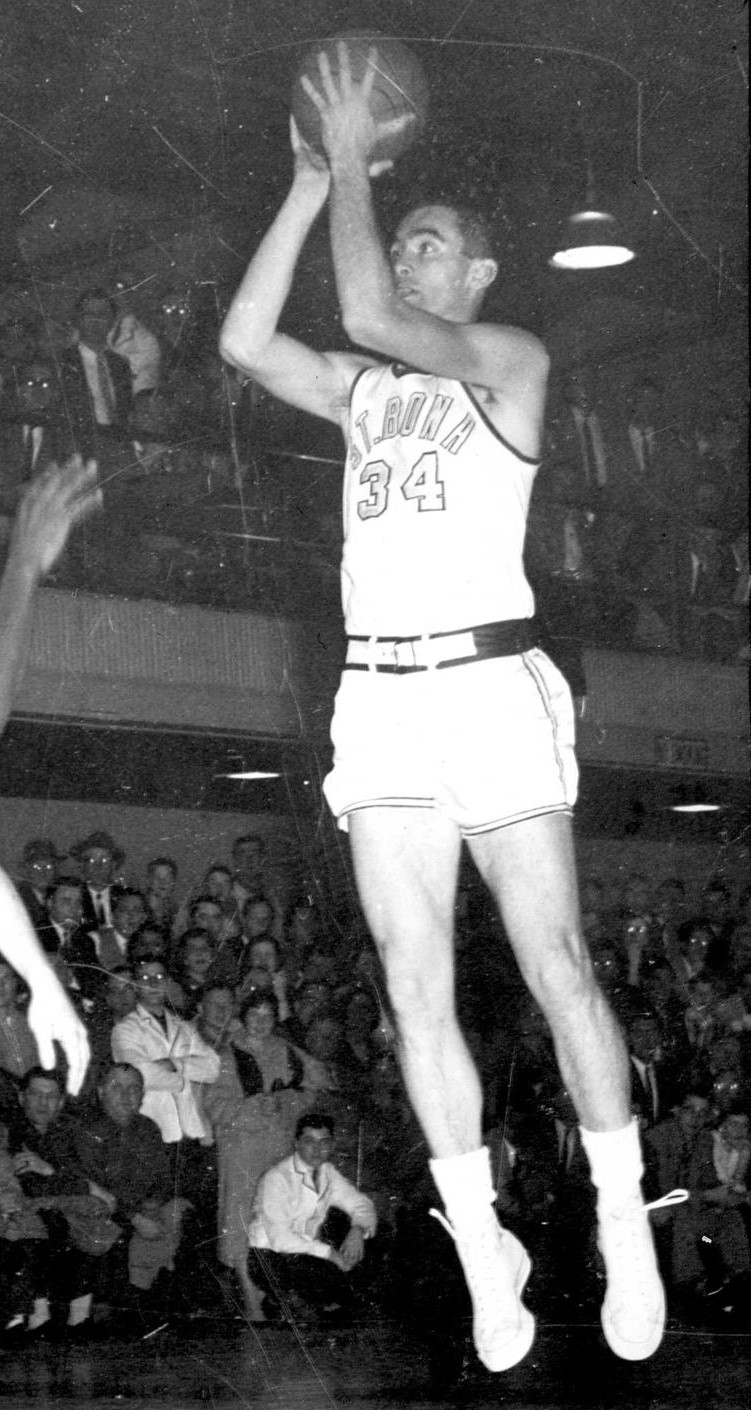
By CHUCKIE MAGGIO
The shot surprised not only the Niagara Purple Eagles’ defense and coaching staff but John Connors’s St. Bonaventure teammates as well.
Niagara, the last school to hand St. Bonaventure a loss at the Olean Armory a decade earlier, had designs on knocking off its Little Three rival once again on Jan. 22, 1958. Taps Gallagher’s 8-2 Purple Eagles, described by the Associated Press as the favorites that night, overcame an early 10-point Bona lead to take the lead on three occasions in the second half.
Connors, the 6-foot-6 center, saw an open opportunity for a crucial basket with under four minutes left.
“We’re still playing for a good shot,” Larry Weise recalled, “and John takes this two-handed set shot from the top of the key. That’s like taking a 3-point shot today, and it went in.”
Bonaventure prevailed 69-66, extending its Armory win streak to 73 games. Gallagher, Weise recalled, told SBU coach Eddie Donovan he never expected Connors to hoist the shot. “John’s our secret weapon,” Donovan replied.
“And he was. It won the game for us, really; it was a key basket,” remarked Weise, Connors’s roommate. “I just remember we were ecstatic. He never took the shot. That was the only time I remember him taking the shot. He took it before; I can’t say he never took it, but he didn’t take it often because he was the center, you know? That was an exciting night for us.”
Connors, a 1958 Bona graduate, died on Christmas Day at 85 years old.
Connors never lost a home game in three years on the SBU varsity team and contributed to four National Invitational Tournament (NIT) victories over his junior and senior seasons. He led the team in rebounding in each of his three seasons and still owns three of the top nine single-game rebounding performances in program history.
One of those NIT wins came against future Naismith Basketball Hall of Famer Elgin Baylor’s Seattle team, an 85-68 rout aided by goading Baylor into early foul trouble.
“John was the first man at practice,” Tom Stith told The Bona Venture in 1998, when Connors was inducted to the St. Bonaventure Athletics Hall of Fame. “He showed up 20 minutes before practice and shot free throws. He did it, and so I started doing it and I continued to do it through my career,”
On a 1957-58 team that included Weise, Ken Fairfield and varsity newcomer Sam Stith, Connors was voted the Most Valuable Player after averaging a double-double. Bona finished third place in the NIT at Madison Square Garden after falling in the third place game to Temple in ‘57.
Connors and his teammates used their hustle and connected defense to overcome any height disadvantage Bonaventure had, outworking opponents on the glass.
“John, he was a tenacious rebounder, tenacious competitor,” Weise noted. “He was a really outstanding rebounder. He’s averaging double figures on offense, and he was probably the best foul shooter we had on the team, and he always backed us up on defense. We had a pressure defense and, of course, John was our center. Whenever anybody got in the alleys, John was there to plug the alley. He backed up our pressure defense very well.
“You’d give the other team one shot, instead of the two or three shots sometimes. They call them putback baskets? John prevented that.”
Connors expanded his athletic repertoire to the baseball mound in the spring, building a reputation for Harry Houdini-esque escapes from bases-loaded jams. The righthander once walked nine Buffalo Bulls batters in five-plus innings, striking out seven more on the strength of a hard fastball.
Even as Connors and Weise graduated and embarked on different professional paths, they remained close friends. Weise stayed at Bona to coach the team from 1961-73 before serving as the school’s athletic director from 1973 to 1992. Connors served in the United States Army, departing as a second lieutenant in 1961, before starting a business career and founding multiple companies.
Connors’s gregarious personality also led him to a term on the Bonaventure board of trustees, where he and his wife Carolyn founded a parish internship program dedicated to “allowing students to explore issues related to their faith and life issues of social justice, peace and the classroom.”
One of Connors’s life mottos, according to his obituary, was that “no one makes it alone” in life. He ensured he never had to go it alone by making fast friends with many he encountered, quick to make an impression.
“John had an infectious personality. Everybody liked John,” Weise said. “And he had a wonderful sense of humor; he could make you laugh. Wherever he went, he made people smile and laugh. He was probably one of the more popular kids on campus, I would say, during his junior and senior year. Because everybody liked John; he got along with everybody. His sense of humor was unmatched.
“He made everybody laugh. He made everybody feel good.”



Great artice. Thank you Chuckie and Larry.